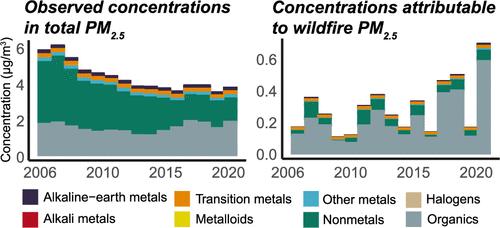The Influence of Wildfire Smoke on Ambient PM2.5 Chemical Species Concentrations in the Contiguous US
IF 11.3
1区 环境科学与生态学
Q1 ENGINEERING, ENVIRONMENTAL
引用次数: 0
Abstract
Wildfires significantly contribute to ambient air pollution, yet our understanding of how wildfire smoke influences specific chemicals and their resulting concentration in smoke remains incomplete. We combine 15 years of daily species-specific PM2.5 concentrations from 700 air pollution monitors with satellite-derived ambient wildfire smoke PM2.5, and use a panel regression to estimate wildfire smoke’s contribution to the concentrations of 27 different chemical species in PM2.5. Wildfire smoke drives detectable increases in the concentration of 25 out of the 27 species with the largest increases observed for organic carbon, elemental carbon, and potassium. We find that smoke originating from wildfires that burned structures had higher concentrations of copper, lead, zinc, and nickel relative to smoke from fires that did not burn structures. Wildfire smoke is responsible for an increasing share of ambient concentrations of multiple species, some of which are particularly harmful to health. Using a risk assessment approach, we find that wildfire-induced enhancement of carcinogenic species concentrations could cause increases in population cancer risk, but these increases are very small relative to other environmental risks. We demonstrate how combining ground-monitored and satellite-derived data can be used to measure wildfire smoke’s influence on chemical concentrations and estimate population exposures at large scales.

野火烟雾对美国周边环境PM2.5化学物质浓度的影响
野火严重加剧了环境空气污染,但我们对野火烟雾如何影响特定化学物质及其在烟雾中产生的浓度的理解仍然不完整。我们将700个空气污染监测仪15年来的每日特定物种PM2.5浓度与卫星获取的环境野火烟雾PM2.5相结合,并使用面板回归来估计野火烟雾对PM2.5中27种不同化学物质浓度的贡献。野火烟雾导致27种碳中25种的浓度明显增加,其中有机碳、元素碳和钾的增幅最大。我们发现,与不燃烧建筑物的火灾产生的烟雾相比,燃烧建筑物的野火产生的烟雾中铜、铅、锌和镍的浓度更高。野火烟雾导致多种物种的环境浓度越来越高,其中一些对健康特别有害。利用风险评估方法,我们发现野火引起的致癌物种浓度的增加可能导致人群癌症风险的增加,但这些增加相对于其他环境风险来说是非常小的。我们展示了如何结合地面监测和卫星衍生数据来测量野火烟雾对化学物质浓度的影响,并在大尺度上估计人口暴露。
本文章由计算机程序翻译,如有差异,请以英文原文为准。
求助全文
约1分钟内获得全文
求助全文
来源期刊

环境科学与技术
环境科学-工程:环境
CiteScore
17.50
自引率
9.60%
发文量
12359
审稿时长
2.8 months
期刊介绍:
Environmental Science & Technology (ES&T) is a co-sponsored academic and technical magazine by the Hubei Provincial Environmental Protection Bureau and the Hubei Provincial Academy of Environmental Sciences.
Environmental Science & Technology (ES&T) holds the status of Chinese core journals, scientific papers source journals of China, Chinese Science Citation Database source journals, and Chinese Academic Journal Comprehensive Evaluation Database source journals. This publication focuses on the academic field of environmental protection, featuring articles related to environmental protection and technical advancements.
 求助内容:
求助内容: 应助结果提醒方式:
应助结果提醒方式:


